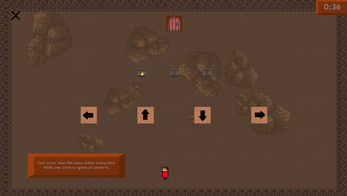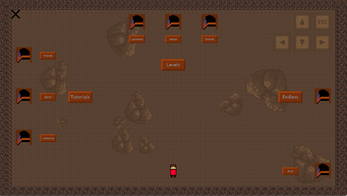Cave Walk (Prototype)
A downloadable game for Windows
What is Cave Walk?
How to Play:
All of the game's puzzles are done using the arrow keys for movement, along with escape and the mouse. Nothing beyond the movement is needed to actually play this game. The maze is simply a matter of moving through the room, while the word scramblers are done by moving over each tile in the correct order. Pressing all the tiles in the wrong order will reset those letters. Finally, the torch puzzle involves pressing the arrows to light all the torches.
Origins:
One thing that everyone was fairly certain about early on was that we wanted to make a puzzle game. All of us are fans of different styles of games, but puzzle games are something everyone, both old and young, can get behind. As such, it simply became a matter of figuring out the puzzles we actually wanted to include, as well as the shell that we wanted to place them inside of. The series of puzzles led us to the idea of a dungeon crawl-esque game, but with puzzles rather than monsters. From there, the story of a mountain just felt natural, and the story fell into place.
Story Concept:
The story of Cave Walk is the tale of a man, Jeffery, who wants to explore a large mountain cave and make it toward the other side. This cave is full of strange puzzles that he must explore before the cave collapses and kills him. The story wasn’t our main focus. In technical terms, it was an excuse for our character to go inside and do puzzles. We came up with the cave aspect from the dungeon crawl aspect…so it turned into a man exploring a mountain full of puddles and danger.
Gameplay:
Cave Walk’s gameplay starts in the main cave area, from which the tutorial, planned, and endless sections can be reached. The tutorial is simply easy examples of each puzzle, designed to teach the players just enough to be able to attempt the larger and more complex puzzles later on. The planned-out section includes puzzles designed to range from simple to challenging, while the endless section contains the same style of puzzles randomized in increasing difficulty. The player can solve all the puzzles and move through the menu simply using the character’s movement, allowing for simple gameplay, but often not easy gameplay. In order to put some stakes into the game, there is a time constraint that varies based on the puzzle, as well as the puzzle’s difficulty.
What Went Right?
What went right making the game:
We were ahead of schedule for essentially the entire process. We were quite dedicated, and there were weekly meetings that had consistent attendance. As such, the pressure felt significantly lighter, and the group was able to communicate well. Any problems were quickly addressed and resolved, with every group member able and willing to give input.
What went right with the game itself:
The game itself fulfills the vision we set out to create, with a character moving through a series of puzzles, either planned or endless. Each of the puzzles included in the final game has its own unique feel, and challenges the player in a different way. The player’s movement feels satisfying, and the game itself makes you feel accomplished for completing the difficult puzzles.
What Were Our Goals?
Puzzles:
Our goal was to create three or more different puzzles that the player could encounter during a run through the cave. The three puzzles we planned to make were a word scramble puzzle, an invisible maze, and a tile flipping puzzle. For the word scramble puzzle, we planned to have the player walk over scrambled letter tiles in the order of a word to open the next door. For the invisible maze, we planned to have the player walk through a room that appeared to be empty but contained a maze the player could not see between them and the next door. For the tile flipping puzzle, we planned to have the player walk over tiles to switch their states and switch the states of all the tiles to open the next door.
Story:
For our story, we wanted to show this retro feel by having a simple story that could easily be interpreted by the player from gameplay alone, but also leave enough for the player to imagine their own story while playing.
Art:
We wished to cultivate a sorta of retro-8 bit art style. All of the sprites that were handmade were simple and mainly focused on easily conveying the purpose of their function. While some of it, admittedly the backgrounds and the cave walls, look a bit more high definition then what we were originally going for, all the art is serviceable and looks appealing to the eye.
What Were Some Issues We Faced?
Failed Puzzles: We went through a variety of failed puzzle ideas in the process of making the game. One was “Break the Ice” style puzzle that was scrapped when we couldn’t come up with a way to randomize it without auto failing the player, the other was a tile flipping puzzle that we scrapped after being unable to find a way to program it.
Although the word scramble and maze puzzles worked well, we weren’t able to program the tile flipping puzzle in a satisfactory way. We had difficulty randomizing the tile flipping puzzle in a way that made it possible to complete and had a controllable minimum length every time it was generated. This puzzle was replaced by a Lanterns puzzle, where the player presses buttons by walking on them to change the on - off state of a row of lanterns, with the player having to light up all the lanterns in order to open the next door.
Programming the Final Puzzles:
Word Scramble: The frustrating part of designing the word scramble puzzle was the organization and layout. Finding a way to balance difficulty and enjoyment through word length and placement took a while to get to a point where the puzzle was enjoyable.
Maze: The difficult part of designing the maze puzzle was creating the maze generator. Finding a way to create a maze that was always possible was an interesting challenge. Once we figured out that we could use two dimensional arrays, making the maze room was genuinely fun.
Lights: The difficult part of programming the lights puzzle was figuring out how to work with an array of objects.
Team Members:
We had two troublesome members in our group, one of which dropped us right before finalizing the group, and another just dropped the class once the groups were formed.
What Would We Have Done Differently?
The Game:
For the game itself, making the art style more consistent would have been nice, but considering that a group member had to step up and take over the art direction despite not having done any art beforehand, the final product is something to be proud of. However, some experience would have been nice.
The Process:
Overall, the production of the game went about as smoothly as can be expected, but the same spent on puzzles that weren’t used for one reason or another would’ve been nice to have working on puzzles that we ended up using.
Final Thoughts:
Benjamin:
Overall, I am proud of what we accomplished with Cave Walk, and am happy with what I was able to provide with art assets and also am happy with the members that stayed until the end.
Wyatt:
I learned a lot about game development, time management, and working with a group during this project and am proud of what our group has accomplished over the past few months.
David:
This was really fun to make. I loved having the opportunity to put my ideas into a cohesive project. It was a good way to practice old skills and learn new ones.
Samuel:
Making a game is a difficult process, but the group we ended up having worked hard and communicated well, and that made for an enjoyable experience. I’m proud of the final product, and I’m proud of each step we took along the way to get to that product.


Leave a comment
Log in with itch.io to leave a comment.